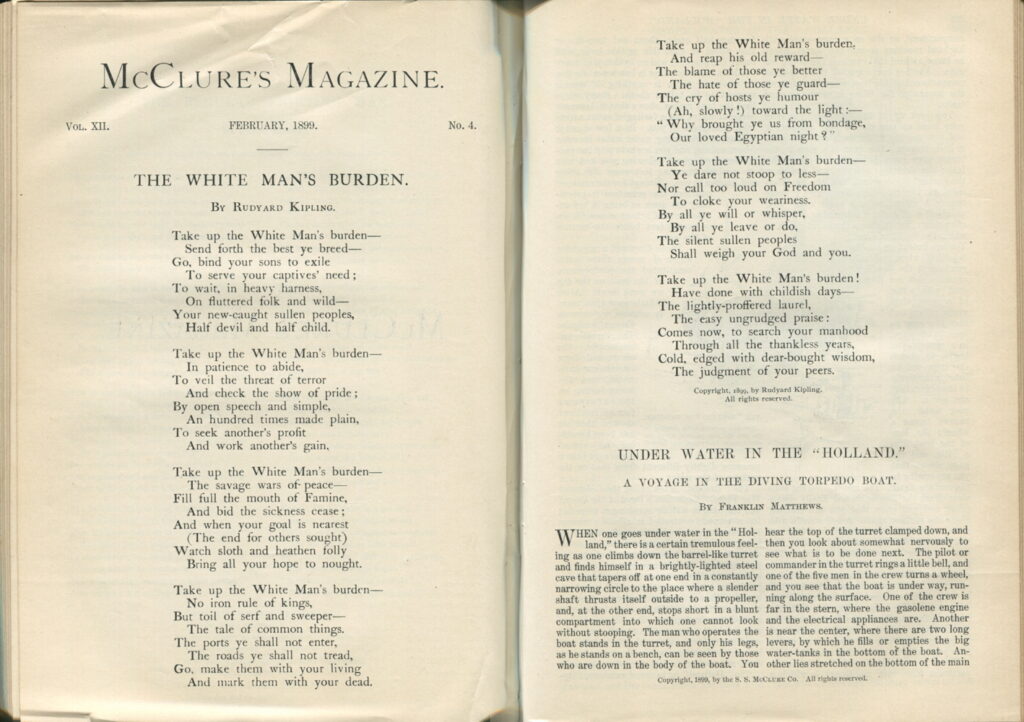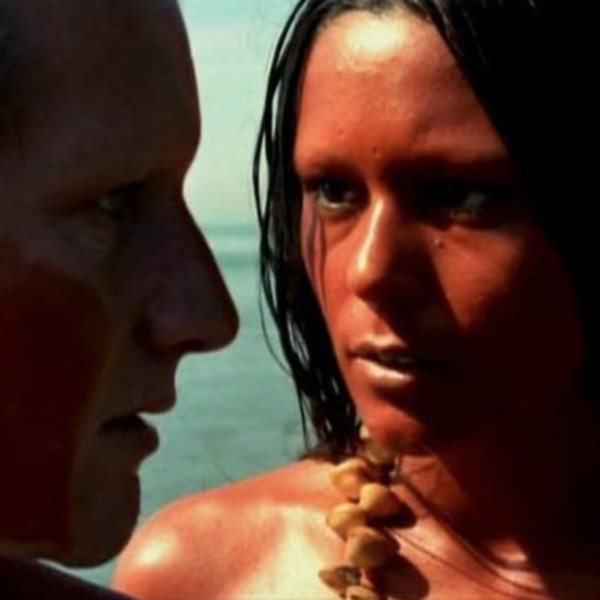by Júnia Caldeira Simão
I am half Portuguese and half Lebanese. But maybe I should say half colonizer and half refugee. I was born and raised in Brazil, the biggest country of South America and also one of the worst cases of slavery in the world and hate crime against indigenous people. Before this class, I had never stopped to think how neocolonialism was part of everything I knew culturally growing up. I am from São Paulo, and as a big city I was surrounded by all mainstream shows, movies and plays Brazil had access to. As my dad being the main influence in my life and who introduced me at an early age in this cultural world. The first movie I watched at the movie theater was Jurassic Park. I was 4 years old and did not fully understand who Spielberg was, or how Hollywood was going to be responsible to me when choosing my profession. I live in New York City now, I look white but I carry my broken accent with me everywhere, which makes me questioning in which niche I see myself in, because I do not see myself represented in the main movies and at the same time I feel that is not my place to use my art and my voice as an artist to advocate for the minority without being point as a white savior. Where do I stand? Or should I stand in one place at all?
With this idea in mind I get confused by the urge I have to label myself and expect the others to identify me in the same way. I came to America seeking for freedom in a world that I could call mine, and at this point in my life I have no idea how to use the resources and knowledges I have access to, to find myself. Thinking about white saviorism, and what is been portrayed in the media, usually is a white character being the only one that can save a person of color in a situation that the white people got them in the first place, but doing some research to find the bottom of this complex that white people have to save minorities. This idea of saviorism was proposed by Rudyard Kipling a britain writer in 1899 with the poem The White Man’s Burden. Kipling urged the United States during the American-Philippines War (1899-1902) with the idea of civilizing the Philippines islands, like many European countries did during colonization. Kipling’s words, made the allusion that white men are the only good ‘breed’ and their main job is to assure the other ‘breeds’ will behave as humans and not animals. This idea was taken among various American imperialists that justified the actions taken to civilization.
The poem
 Kipling’s poem explores the idea that being the colonizer is a burden as “the best ye breed” and the others are wild creatures that needed to be civilized. The poem was written for the white exclusively, as every stanza of the poem starts with Take up the White Man’s burden. The first stanza the writer calls out the white man to assume their burden, which is the fact that they are the best breed so it is their responsibility to ‘save’ the non white people to the deploration they live in, and bring civilization to these people. He calls out that the young should go into exile, starting an intervention to fix the non white population who have been confined for being dangerous animals. The writer indicates the sons as the youth that might take their lives to be able to fix these people, who do not behave as human beings.
Kipling’s poem explores the idea that being the colonizer is a burden as “the best ye breed” and the others are wild creatures that needed to be civilized. The poem was written for the white exclusively, as every stanza of the poem starts with Take up the White Man’s burden. The first stanza the writer calls out the white man to assume their burden, which is the fact that they are the best breed so it is their responsibility to ‘save’ the non white people to the deploration they live in, and bring civilization to these people. He calls out that the young should go into exile, starting an intervention to fix the non white population who have been confined for being dangerous animals. The writer indicates the sons as the youth that might take their lives to be able to fix these people, who do not behave as human beings.
Take up the White Man’s burden –
Send forth the best ye breed –
Go bind your sons to exile
To serve your captives’ need;
To wait in heavy harness
On fluttered folk and wild –
Your new-caught sullen peoples,
Half devil and half child.
The poem also alerts the Americans that this will be a difficult task, but this is what has to be done. Kipling’s words give the illusion that he believes in everything he wrote, and considers this revolution to be the only way to make a civilized world. He gives other points to be considered as colonizers and ends the poem, saying that the leisure days are over, and the youth have to behave like adults and take all the immaturity behind, so they can complete this task.
Take up the White Man’s burden –
Have done with childish days –
The lightly proffered laurel,
The easy, ungrudged praise.
Comes now, to search your manhood
Through all the thankless years,
Cold-edged with dear-bought wisdom,
The judgment of your peers.
The idea of this poem being the root of what we know as white saviorism is really interesting to me, considering that it focuses more on the duties of the white man to vanish the traits of the non white population instead of bringing the stories of these people alive. The ideas of Kipligin are totally racist and are the basis of the poem, but takes out a different view of what white saviorism is portrayed today. Movies and literature along the years still bring to storytelling this type of characters, who brings the knowledge of a certain person or group to the world and make it public instead of try to make them silent, which falls in the same idea of what Kipling believed, but is a personal achievement to the part of the white person over the non white person, instead of a war to make them equal. To Kill a Mockingbird by Harper Lee is a perfect example of what mainstream media portrays the savior – even though this was written more than 60 years ago – as the only key for the salvation of the life of this young black man to go to jail, after been convicted of a rape he did not commit. Atticus is the only hope that this black man has and if it was not for him, he would be another innocent black man to go to jail.
White Savior in HOLLYWOOD; and nowadays
Mainstream movies are still using the white savior complex in their storytelling, usually to describe the hero of the story, most of the time as an ally that falls to become a savior.
White saviorism is something that is still attached to storytelling in general, To Kill a Mockingbird (1962), The Help (2011), The Green Book (2018), Avatar (2009), Freedom Writers (2007), Hidden Figures (2016); The idea that the main character should be a white man and bring all the solutions for people of color and walk out as a hero. The only thing that is worth pointing out, is that The white man’s burden, also became a white woman’s burden, portraying women characters who defined the odds for being a woman, but also falls on the white saviorism. A good example is The Help, directed by Tate Taylor that follows the life of a white journalist fresh out of college, Eugenia “Skeeter” Phelan who decided to write stories of the challenge of a black woman working as a maid for white families. As long as she sympathizes with the other maid characters, she is still viewed as the superior, since she is the one that goes secretly to their houses and not the other way around. She is not colonizing these women, she is using their stories to make her first step to her profession, since she is the one who left the South to be an journalist in New York, and the maids are still not equal to Skeeter. The voices of these black women were somehow heard, but they still fall in the same place they were before.

Avatar is another example of white saviorism, Jake Sully is the colonizer who is sent by the government to Pandora with the objective to take the indigenous Na’vi tribe to leave their home, in order to take precious minerals that are in Pandora soil. Eventually he rebels against the government, and ends up being the key to save the tribe. Jake becomes an ally by leaving his objective to invade their land, but goes back to a savior following the storytelling of the movie. Thinking about this movie, I tried to make a comparison to a brazilian movie we watch in class Como Era Gostoso o Meu Francês (How Tasty Was My Little Frenchman – 1971) where the frenchman character is in captivation by the tribe of the tupinambás, and does everything he can to be equal to them in order to not be killed by them. He works for the tribe, dresses like them and has the same hairstyle as them. He has a ‘wife’ who he tries to bring to his side, but was ambushed by her and served to death at a tribe ceremony, but the interesting thing about this movie is that until the end we believe that the indigenous people won over the colonizers. But the Portuguese who played as their allies, bartering guns to pau brasil trees, are the ones that ended up killing all the tribe. If this third cinema movie follows the story structure of Avatar, the end would not be the same, the Frenchman would probably become an ally of the chief of the tribe and they would fight the Portuguese together. Even though I do not believe that the original ending of How Tasty Was My Little Frenchman would be well accepted to the public today.
Photos: left -A still from “Como Era Gostoso o Meu Francês” (1971); right -A still from “Avatar” (2009)
I believe that white saviorism is still part of the storytelling to identify heroes, a story of an outsider becoming an ally and then savior. This structure has been done for so many years, and will be really hard to detach from it, due to the acceptance of the majority of the public. This complex will still endure for a long time in the cultural industry, until the white man/woman will give opportunities for BIPOC and woman storytellers, to change this scene and give more diversity and new stories to tell. Third Cinema, as all the movies we watched this semester, has been trying to change this format that Hollywood created, for a long time now, by giving voice to minorities, breaking the 4th wall and making the viewers think about the problems presented, discuss about and perhaps try to have a solution.
Reflecting my question about how should I use my art to advocate for minorities, honestly I still do not have an answer for that, but knowing a bit more what white saviorism is and where this comes from, makes me realize that there is a far different of being an ally and being a savior.
Resources:
https://www.healthline.com/health/white-saviorism
https://historymatters.gmu.edu/d/5478/
https://commons.lib.jmu.edu/cgi/viewcontent.cgi?article=1022&context=jmurj
https://visualizingcultures.mit.edu/civilization_and_barbarism/cb_essay01.html
https://www.kiplingsociety.co.uk/poem/poems_burden.htm
https://aninjusticemag.com/avatar-how-white-allies-become-white-saviors-13821ba1dd2e
Featured image: A still from “To Kill a Mockingbird” (1962)

